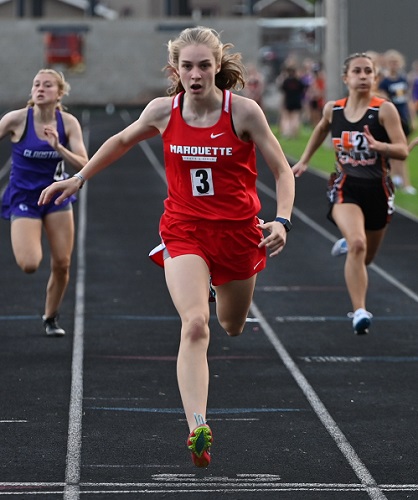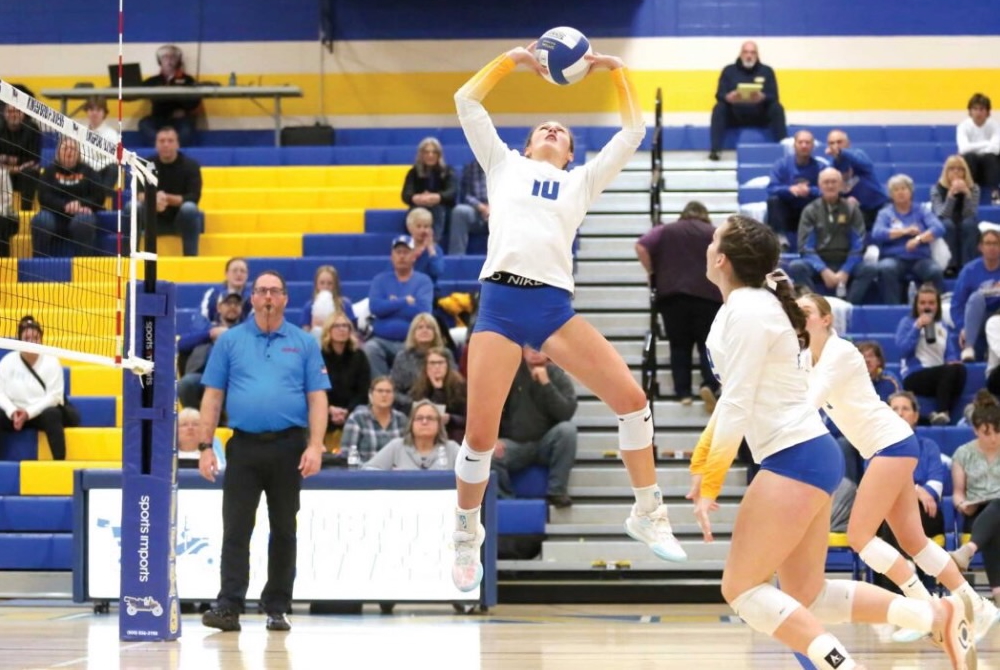
Preview: Past Champions Filling Upper Peninsula Girls Track & Field Finals
By
Geoff Kimmerly
MHSAA.com senior editor
June 2, 2022
An extraordinary 16 individual champions from last season’s Upper Peninsula Girls Track & Field Finals will return to Kingsford this weekend seeking the same success and more. And only six of them are seniors.
The star-studded meet will feature the final high school races for standouts like three-time champion Landry Koski from Rock Mid Peninsula and Houghton distance star Ingrid Seagren. But the Division 2 meet easily could be dominated by sophomores, and the Division 3 Finals return nine of last year’s 13 individual winners including five sophomores and juniors.
Events begin at 10 a.m. (EDT) and tickets to attend can be purchased online only at GoFan. The meets also will be broadcast on MHSAA.tv and viewable with subscription.
Below is a glance at team contenders and individuals to watch in all three divisions.
Division 1
Team forecast: Marquette solidly won its ninth championship over the last 10 seasons (not counting canceled 2020) last spring, but at last month’s Regional edged Sault Ste. Marie by just five points. The Blue Devils were last season’s Finals runner-up as well, and Negaunee in 2018 is the only team other than Marquette to claim a UPD1 championship over the last decade. The Miners had winners in three relays at their Regional and swept hurdles and throws to hold off star-powered Houghton.
Claire Erickson, Sault Ste. Marie junior: The top-seeded contender in the 300 hurdles (50.52) ran the race eight tenths of a second faster than anyone else at a UPD1 Regional. She was third in the 300 at last season’s Finals and ran on two placing relays.
Alyssa Hill, Negaunee senior: She’s seeded first in the discus by nearly 19 feet with a Regional throw of 123-4, and second in shot put at 34 as one of only two (with teammate Eliana Juchemich) who tossed farther than 31-1 in UPD1 qualifying.
 Julia Ott, Marquette junior: She’s seeded second in two events – the 100 and 200 behind teammate Baux Truckey – and tied for the top seed in high jump (5-0) after winning that event last year. She’ll also run on the top-seeded 800 relay and being part of the winning 400 relay in 2021.
Julia Ott, Marquette junior: She’s seeded second in two events – the 100 and 200 behind teammate Baux Truckey – and tied for the top seed in high jump (5-0) after winning that event last year. She’ll also run on the top-seeded 800 relay and being part of the winning 400 relay in 2021.
Ingrid Seagren, Houghton senior: The reigning 1,600 champ is seeded first in that race (5:30.23) by 13 seconds, the 800 (2:30.43) by six seconds and the 3,200 (12:34.34) by six seconds as well. She won the UPD1 cross country championship in the fall.
Baux Truckey, Marquette junior: She entered the mix in a big way last season winning the 100 and 200, and she’s seeded first in both at 12.86 and 26.73 seconds, respectively. She’ll also run on top-seeded 400 and 800 relays after helping both to wins in 2021.
Division 2
Team forecast: West Iron edged Ishpeming by 3½ points at last season’s Final and can match star power with any of the contenders with three-event champion Danica Shamion returning. Ishpeming with another returning three-event champ in Lola Korpi should be in the mix again despite just a third-place Regional finish. Bark River-Harris especially in relays and field events and St. Ignace across the board have enough potential scorers to make this a close meet.
Mckenzie Hoffmeyer, Bark River-Harris sophomore: Her Finals debut last season included the long jump championship and second places in the 100 and 200. She’s seeded first in long jump (15-11½), second in the 200 (27.99) and third in the 100 (13.57) this weekend, and also could run on the top-seeded 800 relay.
Lola Korpi, Ishpeming sophomore: This fall’s UPD2 cross country champion also is the reigning track champion in the 800, 1,600 and 3,200. She’s seeded first in those three in 2:31.91, 5:47.79 and 13:09.59, respectively, but in the 3,200 she’ll have to hold off UPD3 cross country champion Kaylen Clark from Newberry. Korpi also is slated to run on the top-seeded 3,200 relay.
Danielle Lund, Manistique sophomore: She placed sixth in shot put in UPD1 last season, and she enters this weekend seeded first in shot put (33-4) and discus (96-0) in UPD2. She’s also slated to run on the top-seeded 1,600 relay.
Chloe Maycroft, Iron Mountain junior: She’s set to compete in the high jump, long jump and run on two third-seeded relays after winning high jump last season. She’s seeded second in that event (4-8) this time.
Danica Shamion, West Iron County sophomore: She burst onto the scene with championships in the 100, 200 and 400 last season, and she’s seeded first in all three this weekend in 13.2, 27.01 and 1:01.23, respectively. The 200 and 400 meet records could be hers with major performances. She’ll also compete in high jump.
Division 3
Team forecast: Ontonagon broke Lake Linden-Hubbell’s three-season Finals winning streak last spring, and won a closely-contested Regional two weeks ago that saw the top five teams all finish less than 11 points from each other. Relay strength and qualifiers throughout the meet should have the Gladiators in the mix, with Pickford’s potential for a number of meet champions make it another favorite.
Lucy Bennin, Pickford senior: Last season’s 200 champion will run that race again and also is seeded second in long jump (14-3¼) and expected to run on the top-seeded 800 relay and second-seeded 400 relay.
Abi Codere, Lake Linden-Hubbell sophomore: The reigning champion in the 100 hurdles is seeded first in that event (17.45) and also will compete in pole vault.
Ellie Delene, Baraga sophomore: The reigning high jump champion is among 10 qualifiers who went between 4-6 and 4-8 at Regionals. She’ll also run both hurdles races.
Daisy Grinsteiner, Stephenson junior: The returning pole vault champion is seeded first (8-6) by a foot, and she’ll also run on two relays.
Emily Jokela, Lake Linden-Hubbell freshman: She’s set up for a major debut seeded first in the 200 (28.48) and 400 (1:03.00), fourth in the 100 (14.01) and second in the 300 hurdles (52.52).
Landry Koski, Rock Mid Peninsula senior: One of the finest distance runners in the peninsula during her career, she’ll look to add to two 1,600 championships and a 3,200 title she’s won over her first two Finals. She’s seeded first in the 800 (2:39.04), 1,600 (5:44.73) and 3,200 (12:56.05), and third in the 400 (1:04.79).
Lilly McIntyre, Ontonagon junior: She won the 100 last season and will run that race again as well as three relays, including as part of the top-seeded 400 and 1,600 groups.
Tristin Smith, Rudyard senior: Last season’s 400 champion will run that race again, is seeded second in the 1,600 (5:48.64) and will run on two relays including the second-seeded 3,200.
Lizzie Storey, Pickford senior: The reigning 300 hurdles champ is seeded first in that race (50.07) and second in the 100 hurdles (18.18) and also will run on the top-seeded 800 and second-seeded 400 relays.
Makennah Uotila, Ontonagon junior: Last year’s long jump champ is seeded first (14-10½) in that event and fourth in the 400 (1:05.19) and will also run the 800 and potentially as part of the top-seeded 1,600 relay.
PHOTOS Ishpeming's Lola Korpi (1) takes the early lead in the 1,600 at the May 13 Negaunee Lions Invitational, with Negaunee's Marlee Plaxco (3) following close behind. (Middle) Marquette's Julia Ott wins the 200 that afternoon. (Photos by Cara Kamps.)

Kingsford's Kreider Prepared for Next Level After Finishing Stellar Flivvers Career
By
John Vrancic
Special for MHSAA.com
June 19, 2025
KINGSFORD — After completing a successful high school volleyball career, Maddy Kreider is ready to take the next step.
 The Kingsford senior is taking her talents to Michigan Tech, where she’s expected to continue primarily as a setter.
The Kingsford senior is taking her talents to Michigan Tech, where she’s expected to continue primarily as a setter.
“That will be a big step for sure, but it’ll be exciting being with the girls,” she said. “The girls are taller in college. It will definitely be an adjustment, physically and mentally. We’ll be traveling longer distances, and it’ll be a matter of improving the mental part of my game.”
Kreider was selected the Upper Peninsula’s Defensive Player of the Year her final two seasons after the U.P. Sportswriters and Sportscasters Association began voting for all-U.P. volleyball.
“That’s quite an accomplishment,” she said. “It’s a real honor playing with girls I grew up with. We had a great season.”
The 5-foot-8 setter was a four-year starter and two-year team captain at Kingsford, leading the Flivvers to three Division 2 District titles and back-to-back undefeated Great Northern Conference championships. She twice was named GNC Player of the Year.
She was also selected all-state first team in the fall and all-state second team in 2023, and all-region throughout her prep career. Her serving percentage also topped .900 throughout her four seasons on varsity.
 Last fall, the Flivvers reached the Regional Semifinal at Manistique where they dropped a 3-2 decision to Kingsley.
Last fall, the Flivvers reached the Regional Semifinal at Manistique where they dropped a 3-2 decision to Kingsley.
“I thought we’d get through,” Kreider said. “We came out lights out in the first two sets, then it was close in the last three.”
Also among the team’s highlights this past fall was a victory at Calumet, approximately 2½ weeks after dropping a 3-1 decision to the Copper Kings on Kingsford’s home floor.
“We wanted to play them,” Kreider said. “They’re a great bunch of girls to play against. They’ve been the measuring stick up here for many years. Winning on their floor was super exciting. We knew we had to play well just to be competitive. That was a great confidence builder for our group. We were definitely on a high going into the District.”
The Flivvers opened their postseason with a 3-1 triumph over Houghton, then defeated Escanaba in straight sets in the District Final.
Kreider will join Calumet senior Maddie Torola at MTU this fall. Torola, who recorded a season-high 19 kills in the four-set victory at Kingsford, helped the Copper Kings finish 29-5 and reach the Division 3 Regional Final at Sault Ste. Marie where they dropped a 3-2 decision to Traverse City St. Francis.
“It was fun playing against her in high school,” Kreider said. “It will be even more fun playing as teammates. It’ll be exciting to be playing on the same team.”
Both will be playing under new head coach Cindy Pindral at Tech. Both of Kreider’s parents played for the Huskies, her mother (and Kingsford varsity coach) Jaclynn volleyball from 1998-2002 and her father Jason basketball from 1997-2000.
Maddy Kreider recently earned an additional honor when she was selected Female Athlete of the Year for Kingsford’s Class of 2025. She recently completed a solid track & field season for the Flivvers.
At the U.P. Division 1 Finals, Kreider placed fourth in the 100-meter dash (13.2) and anchored the Flivvers to a third-place finish in the 800 relay (1:51.57) and fourth in the 400 (53.03) on their home track.
Kreider was named one of 32 MHSAA/Farm Bureau Insurance Scholar-Athlete Award winners this winter and plans to study exercise science and kinesiology at MTU.
 John Vrancic has covered high school sports in the Upper Peninsula since joining the Escanaba Daily Press staff in 1985. He is known most prominently across the peninsula for his extensive coverage of cross country and track & field that frequently appears in newspapers from the Wisconsin border to Lake Huron. He received the James Trethewey Award for Distinguished Service in 2015 from the Upper Peninsula Sportswriters and Sportscasters Association.
John Vrancic has covered high school sports in the Upper Peninsula since joining the Escanaba Daily Press staff in 1985. He is known most prominently across the peninsula for his extensive coverage of cross country and track & field that frequently appears in newspapers from the Wisconsin border to Lake Huron. He received the James Trethewey Award for Distinguished Service in 2015 from the Upper Peninsula Sportswriters and Sportscasters Association.
PHOTOS (Top) Kingsford’s Maddy Kreider sets for her teammates during a match last season. (Middle) Kreider, right, takes a photo with Kingsford’s Male Athlete of the Year Gavin Grondin. (Photos provided by the Kingsford athletic department.)

